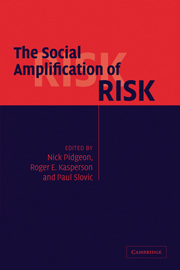Book contents
- Frontmatter
- Contents
- List of figures
- List of tables
- List of contributors
- Acknowledgments
- Introduction
- Part I Conceptual foundations
- Part II Risk signals and the mass media
- 5 Trust, transparency, and social context: implications for social amplification of risk
- 6 Risk and relativity: BSE and the British media
- 7 After amplification: rethinking the role of the media in risk communication
- 8 Plague and arsenic: assignment of blame in the mass media and the social amplification and attenuation of risk
- Part III Public perceptions and social controversy
- Part IV Risk ripples and stigma effects
- Part V Policy and management
- Bibliography
- Index
5 - Trust, transparency, and social context: implications for social amplification of risk
Published online by Cambridge University Press: 06 July 2010
- Frontmatter
- Contents
- List of figures
- List of tables
- List of contributors
- Acknowledgments
- Introduction
- Part I Conceptual foundations
- Part II Risk signals and the mass media
- 5 Trust, transparency, and social context: implications for social amplification of risk
- 6 Risk and relativity: BSE and the British media
- 7 After amplification: rethinking the role of the media in risk communication
- 8 Plague and arsenic: assignment of blame in the mass media and the social amplification and attenuation of risk
- Part III Public perceptions and social controversy
- Part IV Risk ripples and stigma effects
- Part V Policy and management
- Bibliography
- Index
Summary
One element which is an important part of the social amplification of risk framework, and merits further empirical investigation, is the role of public trust in different institutions (for example, regulatory bodies, industries, or non-governmental organizations) in mediating public responses to potential hazards, and any resulting risk amplification or attenuation effects. Social psychological theory offers various frameworks for assessing empirically the importance of trust, and its constituent components, on attitude change. It is proposed that incorporating insights from these theoretical perspectives into the study of the social amplification of risk may provide the basis for empirical tests of the model in future research.
The social amplification of risk framework was proposed to explain why “risk events with minor physical consequences often elicit strong public concern and produce extraordinarily severe social impacts” (Kasperson, Renn, Slovic et al. 1988). Pidgeon, Henwood, and Maguire (1999, p. 70) have commented that the social amplification of risk model serves as “a useful analytical tool for describing and integrating relationships between rival theories of risk perception and communication, and for deriving new signals about the societal processing of risk signals.” However, it is recognized that empirical tests of the model are difficult (Sjöberg 1999), implying that further hypothesis generation might be useful if the model is to be tested and used as a predictive tool in scientific research aimed at understanding public responses to different hazards, and to inform the development of effective risk communication about these hazards.
- Type
- Chapter
- Information
- The Social Amplification of Risk , pp. 123 - 137Publisher: Cambridge University PressPrint publication year: 2003
- 33
- Cited by

